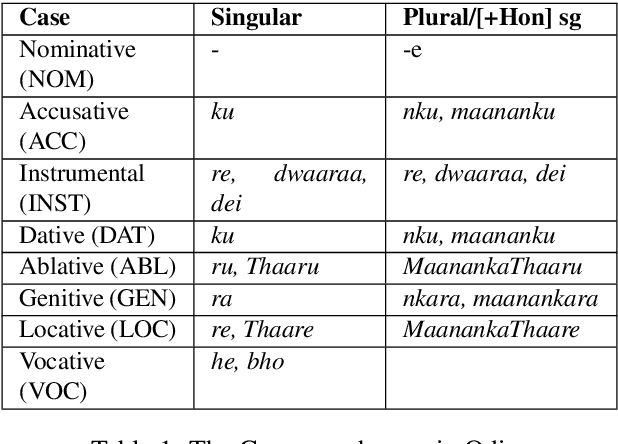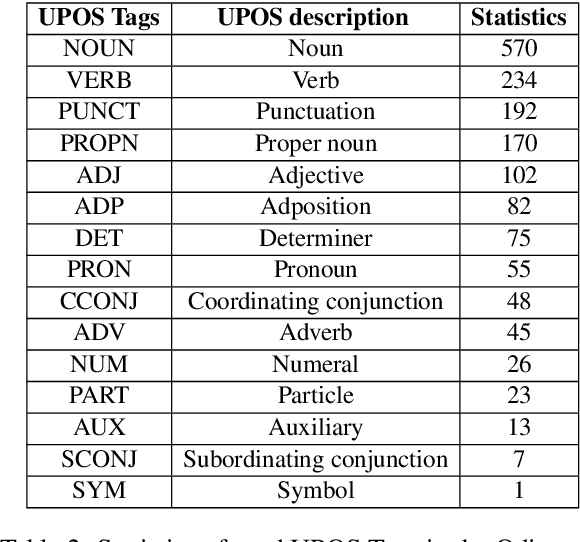Satya Ranjan Dash
Universal Dependency Treebank for Odia Language
May 24, 2022



Abstract:This paper presents the first publicly available treebank of Odia, a morphologically rich low resource Indian language. The treebank contains approx. 1082 tokens (100 sentences) in Odia selected from "Samantar", the largest available parallel corpora collection for Indic languages. All the selected sentences are manually annotated following the ``Universal Dependency (UD)" guidelines. The morphological analysis of the Odia treebank was performed using machine learning techniques. The Odia annotated treebank will enrich the Odia language resource and will help in building language technology tools for cross-lingual learning and typological research. We also build a preliminary Odia parser using a machine learning approach. The accuracy of the parser is 86.6% Tokenization, 64.1% UPOS, 63.78% XPOS, 42.04% UAS and 21.34% LAS. Finally, the paper briefly discusses the linguistic analysis of the Odia UD treebank.
Hausa Visual Genome: A Dataset for Multi-Modal English to Hausa Machine Translation
May 06, 2022



Abstract:Multi-modal Machine Translation (MMT) enables the use of visual information to enhance the quality of translations. The visual information can serve as a valuable piece of context information to decrease the ambiguity of input sentences. Despite the increasing popularity of such a technique, good and sizeable datasets are scarce, limiting the full extent of their potential. Hausa, a Chadic language, is a member of the Afro-Asiatic language family. It is estimated that about 100 to 150 million people speak the language, with more than 80 million indigenous speakers. This is more than any of the other Chadic languages. Despite a large number of speakers, the Hausa language is considered low-resource in natural language processing (NLP). This is due to the absence of sufficient resources to implement most NLP tasks. While some datasets exist, they are either scarce, machine-generated, or in the religious domain. Therefore, there is a need to create training and evaluation data for implementing machine learning tasks and bridging the research gap in the language. This work presents the Hausa Visual Genome (HaVG), a dataset that contains the description of an image or a section within the image in Hausa and its equivalent in English. To prepare the dataset, we started by translating the English description of the images in the Hindi Visual Genome (HVG) into Hausa automatically. Afterward, the synthetic Hausa data was carefully post-edited considering the respective images. The dataset comprises 32,923 images and their descriptions that are divided into training, development, test, and challenge test set. The Hausa Visual Genome is the first dataset of its kind and can be used for Hausa-English machine translation, multi-modal research, and image description, among various other natural language processing and generation tasks.
Hindi Visual Genome: A Dataset for Multimodal English-to-Hindi Machine Translation
Jul 21, 2019



Abstract:Visual Genome is a dataset connecting structured image information with English language. We present ``Hindi Visual Genome'', a multimodal dataset consisting of text and images suitable for English-Hindi multimodal machine translation task and multimodal research. We have selected short English segments (captions) from Visual Genome along with associated images and automatically translated them to Hindi with manual post-editing which took the associated images into account. We prepared a set of 31525 segments, accompanied by a challenge test set of 1400 segments. This challenge test set was created by searching for (particularly) ambiguous English words based on the embedding similarity and manually selecting those where the image helps to resolve the ambiguity. Our dataset is the first for multimodal English-Hindi machine translation, freely available for non-commercial research purposes. Our Hindi version of Visual Genome also allows to create Hindi image labelers or other practical tools. Hindi Visual Genome also serves in Workshop on Asian Translation (WAT) 2019 Multi-Modal Translation Task.
 Add to Chrome
Add to Chrome Add to Firefox
Add to Firefox Add to Edge
Add to Edge